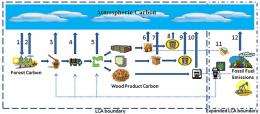Analysis raises atmospheric, ecologic and economic doubts about forest bioenergy

A large, global move to produce more energy from forest biomass may be possible and already is beginning in some places, but scientists say in a new analysis that such large-scale bioenergy production from forest biomass is unsustainable and will increase greenhouse gas emissions.
Early suggestions that such a forest biofuel industry would be greenhouse "neutral" or even reduce greenhouse emissions "are based on erroneous assumptions," a group of international researchers said in an invited analysis in Global Change Biology/Bioenergy, a professional journal.
A major increase in this industry, they concluded, would also result in shorter tree rotations, younger forests, depleted soil nutrients, increased risk of erosion, loss of forest biodiversity and function, higher costs for bioenergy than are now being anticipated, and increased use of fertilizers – also a source of greenhouse emissions.
"The main objective of bioenergy production from forest harvest is to reduce greenhouse gas emissions, but the strategy is likely to miss the mark," said Beverly Law, a professor of forest science at Oregon State University and one of the co-authors.
This report was led by the Max-Planck Institute for Biogeochemistry in Germany, OSU, and other universities in Switzerland, Austria and France. The work was supported by several agencies in Europe and the U.S. Department of Energy.
"The article raises important issues for bioenergy policies," said co-author Helmut Haberl, who is also an author of the climate mitigation chapter of the fifth assessment that is under way by the Intergovernmental Panel on Climate Change.
This analysis was based on a theoretical, significant increase in energy from forest biomass, as has been proposed by some researchers, to 20 percent or more of current global primary energy supply. For instance, about 20 percent of all European Union energy consumption is supposed to come from renewable sources by 2020, with bioenergy as a focal point.
Advocates of such approaches, which would use forest biomass either for direct combustion or by conversion to biofuels, say that this could significantly decrease global dependence on fossil fuels without competing with food production, and in many cases create local jobs.
A major initiative is now under way in the Pacific Northwest of the U.S. to study just such possibilities and produce some of the aviation fuel of the future, in the process creating jobs and helping to thin regional forests. However, it is much less ambitious than the scenarios studied in the new analysis.
In this report, and based on large-scale use of biofuels as proposed in some policies, the scientists outlined a number of concerns. They include:
- The general assumption that bioenergy is carbon-neutral is not valid.
- The reduction of biomass and lost carbon sequestration by forests could take decades to centuries to be "paid back" by fossil fuel substitution, if paid back at all.
- There are significant concerns about the economic viability of biofuels, which may require government mandates or subsidies.
- A higher demand for biomass from forests will increase prices for the biomass, as in Germany where they have already increased in price 300-600 percent from 2005 to 2010.
- An emphasis on bioenergy production from forests could lead to shorter rotation lengths, questionable management practices and increased dependence on wood imports.
- Negative impacts on vegetation, soil fertility, water and ecosystem diversity are all possible.
- Fertilizer use, another important source of greenhouse gas emissions, could increase.
- The use of fossil fuels in the Industrial Revolution allowed previously degraded forests to recover in much of Europe and the U.S., while industrial-scale use of forests for biomass would likely reverse this trend.
"Society should fully quantify direct and indirect greenhouse gas emissions associated with energy alternatives, and associated consequences, prior to making policy commitments that have long-term effects on global forests," the authors wrote in their conclusion.
"There is substantial risk of sacrificing forest integrity and sustainability with no guarantee to mitigate climate change," they said.
More information: ncfp.files.wordpress.com/2012/ … r-carbon-neutral.pdf
Provided by Oregon State University


















